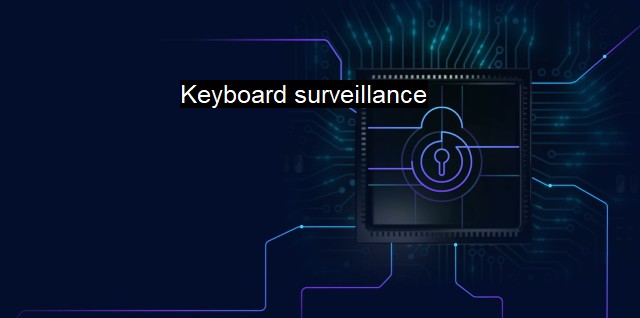What is Keyboard surveillance?
Unveiling Keyboard Surveillance: The Mechanism behind Spyware for Information Theft and its Crucial Role in Cybersecurity
Keyboard surveillance, often referred to as keylogging or keystroke logging, is a method used in cybersecurity and data theft where a malicious entity records or logs the keys struck on a keyboard. This tactic is typically employed without the permission or even knowledge of the person using the keyboard. With keylogging software, threat actors can capture every keystroke made by a user, providing them with access to private information such as login credentials, credit card details, important confidential messages, and other personal data.The keylogger can either be a physical device or software. A physical keylogger is a small hardware device inserted between the keyboard and the computer. Technically, it can only be deployed by someone with physical access to the target computer. These devices are thus more commonly used in targeted attacks. From a cybersecurity perspective, physical keyloggers are relatively easier to detect and handle through routine physical examination of the system components.
On the other hand, software keyloggers work based on a program or script used to record keystrokes. This method poses a major threat to cybersecurity, as cybercriminals often find ways to infect victim computers remotely via the internet such as through email attachments, links, or even embedded in formal software updates. Because they perform their functions covertly, software keyloggers are harder to detect and represent a serious threat to both individuals and organizations.
Once a keylogger is installed or activated, it begins to document and send every keystroke done at the infected computer to the malicious actor. Often, this compiled data is either stored for later use or instantly relayed back to the hacker, often without either the system or the user noticing this illicit data transfer.
Because keyloggers are designed to run in the background, they generally don't disrupt standard computing habits, making detection extremely challenging. Onwards to this is how diverse these forms of malware are; with keylogger being a technique and not a specific software, malicious actors can constantly refine their tactics and techniques, making it difficult for traditional antivirus software to detect them.
This brings us to the topic of countering keyloggers. The first line of defense against all forms of cyberattacks, including keylogging, is vigilance and informed behavior. Avoid opening suspicious-looking emails or clicking on urls from unknown sources. Scan all email attachments before opening them, even if they appear to be from a familiar source.
Second, you need robust antivirus software that can effectively catch keyloggers. Regularly updating and upgrading this software is just as important, as it ensures protection against emerging threats. A few antivirus programs have specialized tools for detecting both known and unknown keyloggers. Besides antivirus software, using anti-keylogging software offers another level of protection.
a two-factor authentication (2FA) or multi-factor authentication (MFA) solution provides another safety layer against potential attacks. Even if a cybercriminal succeeds in logging keystrokes, they may not bypass these authentication steps. Additional biometric measures, such as fingerprint recognition or facial recognition, also hold a significant line of defense.
Understanding what keyboard surveillance or keylogging involves is the first step towards safeguarding personal data and ensuring secure digital interactions. In the face of increasing volumes of cyber threats, a preventive and proactive approach remains the most effective weapon. Cybersecurity is not only about having the right tools but also about being knowledgeable about these threats and exercising sensible online behaviors.

Keyboard surveillance FAQs
What is keyboard surveillance?
Keyboard surveillance refers to the practice of monitoring someone's keystrokes or keyboard activity without their knowledge or consent for the purpose of spying or stealing sensitive information.Why is keyboard surveillance a cybersecurity risk?
Keyboard surveillance allows attackers to steal sensitive information, such as usernames, passwords, credit card numbers, and other confidential data. This can lead to identity theft, financial losses, and other cybersecurity threats.How can I prevent keyboard surveillance?
You can prevent keyboard surveillance by installing reputable antivirus software, using a virtual private network (VPN), avoiding suspicious websites or links, and being cautious of unsolicited emails or messages. Additionally, you can use a privacy screen or physical keyboard cover to prevent others from seeing your keystrokes.Is keyboard surveillance illegal?
In most countries, keyboard surveillance without consent is considered illegal, as it violates privacy laws. However, some organizations or employers may have legitimate reasons for monitoring employees' keyboard activity, provided that they obtain consent or inform the employees beforehand.| | A | | | B | | | C | | | D | | | E | | | F | | | G | | | H | | | I | | | J | | | K | | | L | | | M | |
| | N | | | O | | | P | | | Q | | | R | | | S | | | T | | | U | | | V | | | W | | | X | | | Y | | | Z | |
| | 1 | | | 2 | | | 3 | | | 4 | | | 7 | | | 8 | | |||||||